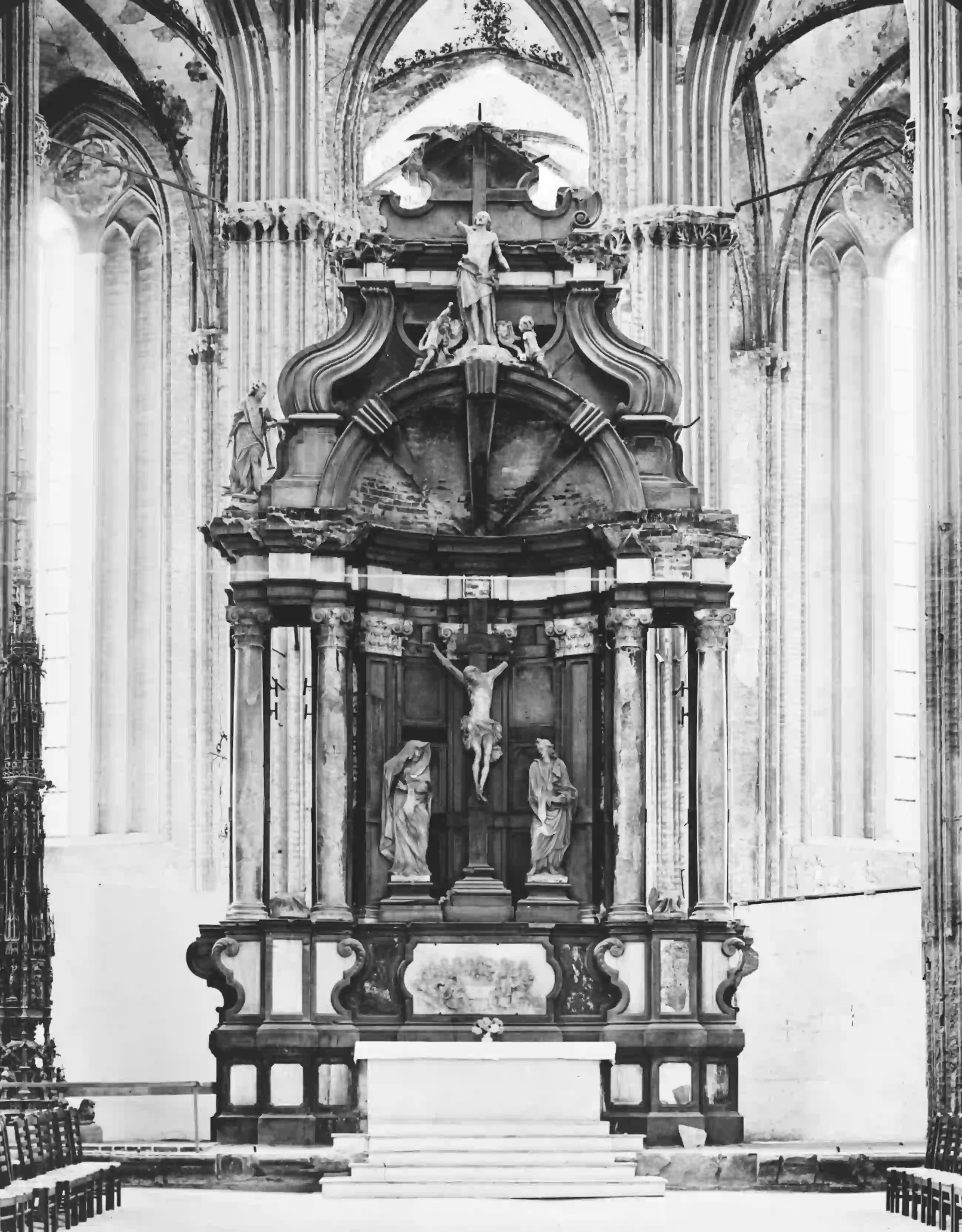Fredenhagen-Altar
Masterpiece of North German Baroque art
An important altar for an important city.
On this page
The Fredenhagen-Altar (by Svea Regine-Feldhoff)
St Marien in its present form was built in the decades before and after 1300 and was an expression of the proud and wealthy bourgeoisie of a town free of wealth. The church was built right next to the town hall and the market square on the highest point of the town centre. St Marien was the church of the council and the merchants, so there was always a close connection to the merchant community. Since the 17th century, for example, the Lübeck Evening Music at St Marien has been sponsored by the merchants. In terms of church law, St Marien, like all other churches in Lübeck, was subject to the cathedral chapter. The theory that the merchants wanted to confront the secular power in a provocative manner is therefore at least questionable.
Wealthy citizens were keen to erect a monument in "their" church. High-quality sacred works of art were donated. The tombstones or cenotaphs originally set into the floor, i.e. mock graves dedicated to the memory of one person only, increasingly moved to the pillars and walls. Initially memorial slabs with inscriptions, elaborate epitaphs were created, especially in the 16th and 17th centuries, to reflect the growing need for representation and the enormous influence of merchants not only in the economic but also in the political and cultural sphere.
One of the most productive epitaph artists of his time was the Antwerp sculptor Thomas Quellinus (1661-1709), who ran a large workshop in Copenhagen that was well known throughout Europe. His most famous work in northern Germany is the altar he created for St Marien on behalf of Lübeck councillor Thomas Fredenhagen (1627-1709). Quellinus worked on this altar partly in St Marien itself, as it had to fit exactly between the two columns in the high choir.

"The enormous marble structure, perfectly matched to the dimensions of the choir, was a major work of Flemish late Baroque of European standing and had a significant influence on altar art in the country" (Lutz Wilde in dehio, Handbuch der Deutschen Kunstdenkmäler. Hamburg, Schleswig-Holstein 1971, p. 337).
In fact, the altars in St Aegidien or St Jakobi in Lübeck, for example, can also be regarded as epigonal, while the Fredenhagen altar in St Marien provides evidence of an innovative original from an art-historical perspective.
Thomas Fredenhagen had achieved enormous wealth as a merchant and shipowner and was probably the richest man in Lübeck of his time. He had been a member of the church council of St Marien since 1680. In 1695, Fredenhagen had granted the city of Lübeck a loan of 100,000 Lübische Marks, an unimaginably large sum. The new altar was completed in August 1697. Of course, Fredenhagen also had an ulterior motive - the altar was also to be his own tomb. The altar was the largest donation to a Lübeck church since the Reformation. The Fredenhagen Altar can also be regarded as the most important post-Reformation sacred work of art in Northern Europe to date.

Until the Palmarum bombing in 1942, the interior of St Marien was dominated by Baroque epitaphs: over 80 had been preserved by then, and around 60 more are known from documents. All the wooden epitaphs in the nave were burnt in the bombing raid, and the altar was also badly damaged. The congregation decided not to rebuild it but, like the destroyed bells, initially left it standing as a reminder against the war. The Fredenhagen altar was only torn down in 1958 at the special request of the bishop at the time. St Marien's organist Walter Kraft was also in favour of demolition, so the church council made this decision. It was controversial from the outset, and numerous publications document this discourse to this day. Those in favour of demolition rejoiced at the further liberation from baroque art, praised the free space that had been created and pursued a re-gothicisation of the church interior. Those in favour of restoring the Fredenhagen altar knew and still know the importance of the altar as a work of art, its significance for the city, the music and the acoustics of the church interior.
The base of the Fredenhagen altar was left standing and disappeared into the embankment that was created to significantly raise the height of the choir. A simple limestone altar table was placed on top. A crucifix by the artist Gerhard Marcks was hung above it. A small Gothic altar of the Virgin Mary from a side chapel completed the new ensemble. These measures are still controversial today.
The Fredenhagen altar is currently torn apart: some marble figures have been placed in different parts of the church, while the basic construction is stored in the north tower.
The altar and the music in the church (by St. Marien Organist Johannes Unger)
While the Gothic hall church, built in the 13th century, was initially a place for monophonic singing, for example during the Liturgy of the Hours, the complexity of the music developed over the centuries in parallel with the acoustic conditions, which were mainly determined by the increasing interior decoration of the church (stalls, epitaphs, galleries, organs, choir, high altar, banners). In the 16th and 17th centuries, an evenly distributed sound and reduced reverberation times were unavoidable for polyphony and the multiple choirs (up to 6 ensembles at the same time) documented for St. Marien, and were very likely achieved, even if the size of the room always presented a challenge for the musicians.
The destruction of the war in 1942 changed the acoustic conditions back to the 13th century in one fell swoop. All the wooden and marble fixtures, the choir screen that structured the room, the many surfaces that diffusely reflected the sound and even the sound-absorbing lime colours had disappeared. The demolition of the large Fredenhagen altar, the last remaining large reflective surface in the high choir, marked the end of a sudden development that makes making music in this room extremely difficult in many parts.


